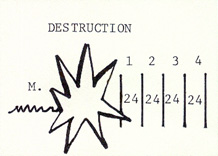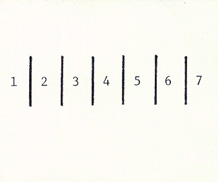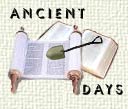What are the "DAYS"? How long were they?
Some Dates for Creation:
- Septuagint 5270 BC
- Jewish 3760 BC
- Josephus 5555 BC
- Luther 3961 BC
- Kepler 3993 BC
- Ussher 4004
BC
Some Interpretations of the Meaning of "Days"
- Revelational day: God revealed to Moses how He did it in 6 visionary
days, or during a 6 day period.
- Long period of time -- a geological age -- a "day-age".
- Literal day (24 hours), separated by long ages.
- See chart below...
Theories of the Origin of the Universe Which Some Christians Hold
|
Theistic Evolution:
God used natural (evolutionary) processes to bring all things into
existence. The Bible only tells "who", not "how". |
 |
Progressive Creation:
God is continually creating new forms of life over vast periods of time.
(Evolutionists refer to "punctuated equilibrium".) |
 |
Day-Age Theory:
Each "day" of the creation week was actually a long (geological) period of time. |
 |
Day-Age Variant:
Creation took six 24 hour days. But there were enormous periods of time between. |
 |
Gap Theory:
God created heaven and earth which continued for an undetermined length
of time (Genesis 1:1). He destroyed it during a "gap" between verses
1 and 2. Then, He recreated it in verse 2, in six 24 hour days. [This
theory was originally expounded by C. I. Scofield and popularized
through his study Bible.] |
 |
Framework Hypothesis:
Genesis 1-11 is composed of themes ("creation", "fall", "reconciliation", etc.)
which are simply introduced here, but recur throughout Scripture. Or, it is only "poetry", "allegory",
"suprahistory". |
 |
| Please notice that all the above try to reconcile vast
stretches of time with what appears to be a few thousand years in
the Bible. A common cliché is, "The Bible does not give the
date of the earth's origin." |
Young Earth/Universe (and a universal Flood):
God created the earth and universe miraculously and mature. Great catastrophes have occurred during the earth's
history which account for geological deposits. At least one of these was Noah's Flood which was universal,
created many layers of sediment and will account for much of geology with its fossils.
|
 |
Important Factors in Determining the Length of Days
- The use of the phrase "evening and morning" is the Hebrew definition of a 24 hour day and is in current use today
to mean the same thing. It is used this way more than 100 times in the Old Testament (Tanach) and each time it always means
a 24 hour day. If the writer wanted to convey the impression of 6 LITERAL days, how else would he have worded it? Would he
word it this way if he really meant "long ages"? Long ages do not have evenings and mornings.
- Ordinal numbers are used in reference to the days: first, second,
third, etc. Ordinal numbers are always used to indicate 24 hour
days more than 200 times in the Old Testament and over 100 times in
the New Testament. Even today that is how the days of the week are named
in Hebrew.
- In Hebrew, 95% of the time the word yom normally means a 24 hour day. (See a Hebrew lexicon
for the meaning of yom). Yom is used 1200 times to mean "day" in Scripture, and 700 times in its
plural form to mean "days". Only 5% of the time (about 65 times) is yom used to indicate an
indefinite period of time or an event (as in, for example, the "day of the Lord"). Normally, when it is used
to refer to something besides a literal 24 hour day, there is usually some indication, such
as yom rab, which means a "long time". Another word, olam, is used when "ages" or "aeons" of time are
meant.
- The Sabbath day of rest (the 7th day) must have been literal. Genesis 1:31 - 2:3 states God "rested" -- not "is resting".
In Exodus 20, the Ten Commandments equate a 7 day week with the creation week. In Exodus 31:12-17, keeping the Sabbath is to be a sign
of a witness to God's creation of the world.
Objections to a Literal Day Interpretation
- "II Peter 3:18 states that 'one day equals 1000 years'." This can go
both ways -- what SEEMS like 1000 years can equal only a day. [It is
interesting to note, during New Testament times, many Jewish scholars
felt that the 24 hour days in Creation were representative of the 1000
year periods of the ages of man. Even today the rabbis speak of there being six thousand
years given to man and then Messiah will come.]
- "The sun was not created until the 4th day. What does 'day and night' mean?"
[Conversely, how do plants and animals live through a long period of
time that is "night"? or become badly sunburned during a long period
of "day"?]
- "Too much happened on the 6th day for it to be only 24 hours -- first Adam was made, then all of the animals, then they were named,
then Adam was lonely, then Eve was made -- all in one day?" [If all the animals were in Adam's presence and brought before him for
the naming, it would only take a few hours for him to name them.]
- "A long day-age (long periods of time) fits the geological scheme better." [This perception of the lengthy "geological scheme"
ignores the Flood and its cataclysmic destruction --
ages are not needed. Too much credit is being given to geologists.]
The belief that yom represents long ages allows for death BEFORE
Adam even sinned in the Garden of Eden. Adam's age is stated in Scripture;
belief in ages for creation days does not add up.
Conclusion
Attempts to stretch
time appear to be an effort to accomodate an evolutionary
philosophy and world view.
The MOST important point is:
GOD DWELLS in ETERNITY, NOT in TIME.
HE works MIRACLES, WHICH ELIMINATE TIME!
|

